译林版(2020)必修第三册Unit 3 The world Online Grammar and usage 非谓语动词课件(共56张PPT)
文档属性
| 名称 | 译林版(2020)必修第三册Unit 3 The world Online Grammar and usage 非谓语动词课件(共56张PPT) |  | |
| 格式 | pptx | ||
| 文件大小 | 3.7MB | ||
| 资源类型 | 教案 | ||
| 版本资源 | 牛津译林版(2019) | ||
| 科目 | 英语 | ||
| 更新时间 | 2024-05-22 14:54:49 | ||
图片预览



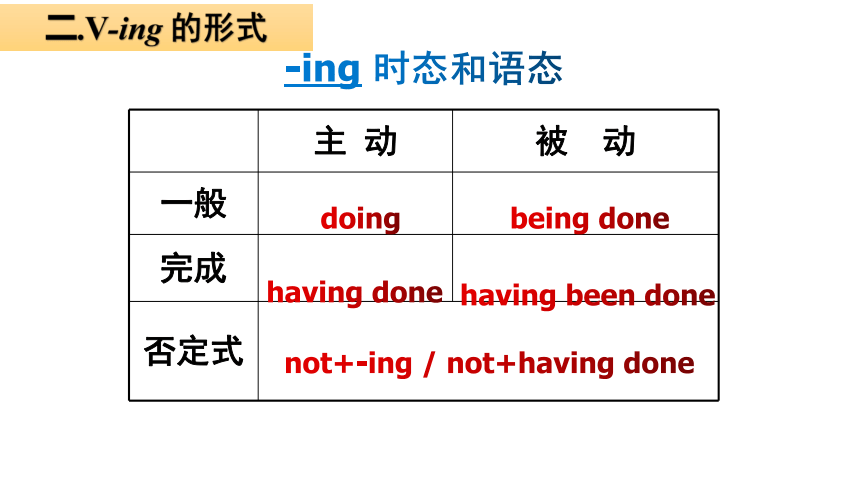
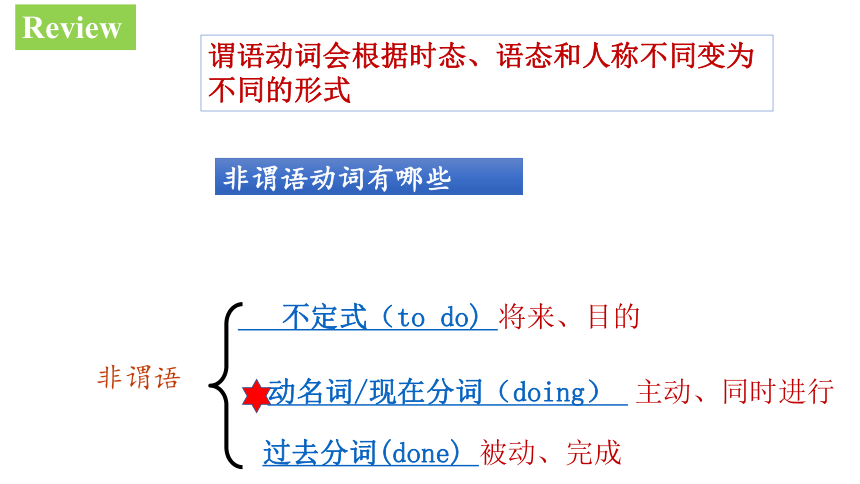


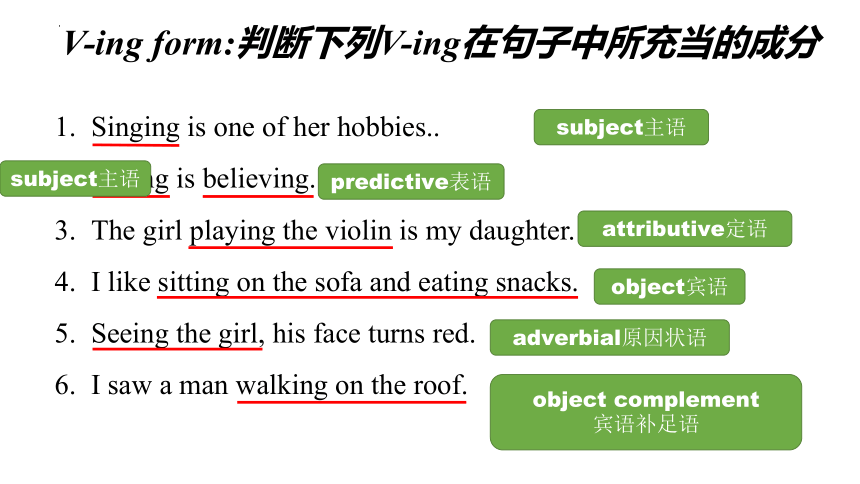

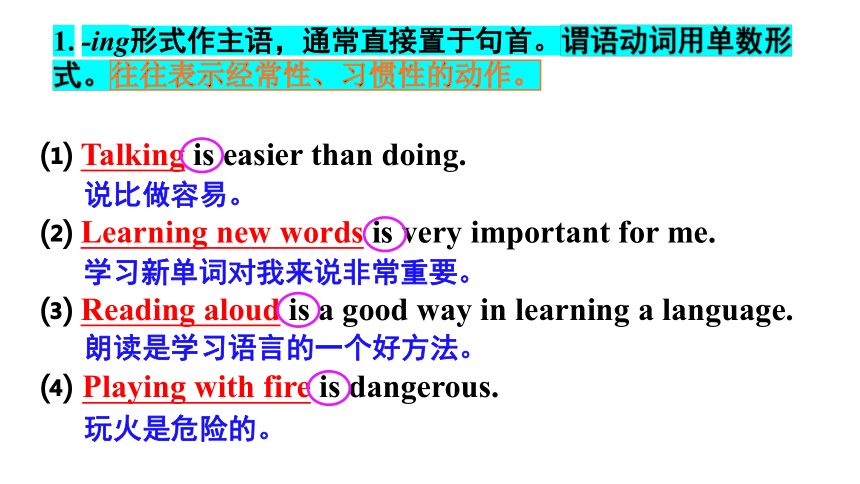

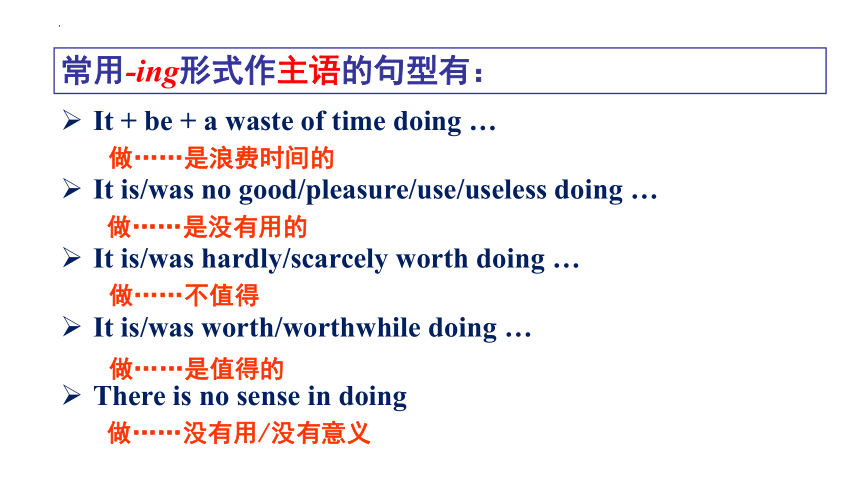
文档简介
(共56张PPT)
Unit 3 The world online
Grammar & usage
非谓语动词 之 v-ing
Learn how to annalyse and identify the uses of
–ing forms
To apply the rules by doing some exercises.
一.V-ing 的名称
动名词
现在分词
V-ing 的名称
-ing 时态和语态
主 动 被 动
一般
完成
否定式
doing
being done
having done
having been done
not+-ing / not+having done
二.V-ing 的形式
在句子中充当谓语的动词;
非谓语
不定式(to do) 将来、目的
动名词/现在分词(doing) 主动、同时进行
过去分词(done) 被动、完成
非谓语动词有哪些
谓语动词会根据时态、语态和人称不同变为不同的形式
Review
解读:
1. v-ing的一般式和完成式:
v-ing的一般式doing/being done表示和谓语动词的动作同时进行;完成式having done /having been done表示动作发生在谓语动词之前。
如: Hearing the good news, they couldn’t help laughing.
Having finished homework, he went to sleep.
He apologized to the manager for not having kept his promise.
2.v-ing的被动式:
v-ing的被动式表示它的逻辑主语是动作的承受者。根据v-ing动作发生的时间,v-ing的被动式分为进行被动式(being done)和完成被动式(having been done)
如: The problem being discussed at the meeting is very important.正在被讨论的 Having been punished many times, he still made the same mistake. 已被惩罚过
v-ing功能分类
v-ing形式
动名词
现在分词
主语
宾语
表语
定语
定语
表语
状语
宾补
Playing with fire is dangerous.
Jim likes jumping in muddy puddles.
Her idea is building up a new company.
People living there are quite friendly.
He really needs a washing machine.
The performance was really amazing.
Laughing and talking, they went in.
I love to watch her performing on the stage.
V-ing form:判断下列V-ing在句子中所充当的成分
Singing is one of her hobbies..
Seeing is believing.
The girl playing the violin is my daughter.
I like sitting on the sofa and eating snacks.
Seeing the girl, his face turns red.
I saw a man walking on the roof.
subject主语
subject主语
predictive表语
attributive定语
object宾语
adverbial原因状语
object complement
宾语补足语
一、动词-ing形式作主语
⑴ Talking is easier than doing.
⑵ Learning new words is very important for me.
⑶ Reading aloud is a good way in learning a language.
⑷ Playing with fire is dangerous.
朗读是学习语言的一个好方法。
1. -ing形式作主语,通常直接置于句首。谓语动词用单数形式。往往表示经常性、习惯性的动作。
说比做容易。
学习新单词对我来说非常重要。
玩火是危险的。
⑴ It's worth making the effort.
⑵ It is pleasant working with you.
⑶ It's no use crying over split milk.
⑷ It was a waste of time reading that book.
这件事值得努力去做。
和你一起工作很愉快。
覆水难收。
看那本书是浪费时间。
3. 有时可用it作形式主语前置,真正的主语是 -ing形式。
但这种句子形式有一定的限制,作表语的只能是某些形容词或少数名词。
形容词
名词
常用-ing形式作主语的句型有:
It + be + a waste of time doing …
It is/was no good/pleasure/use/useless doing …
It is/was hardly/scarcely worth doing …
It is/was worth/worthwhile doing …
There is no sense in doing
做……是浪费时间的
做……是没有用的
做……不值得
做……是值得的
做……没有用/没有意义
【归纳用法】动词 ing形式作主语表示比较抽象的一般行为,to do作主语往往表示具体的或一次性的动作。
4.
5.
动词-ing 形式的复合结构
动词 -ing 形式加上自己的逻辑主语,便构成了动词 -ing 形式的复合结构。其逻辑主语可以是形容词性物主代词、名词所有格、人称代词的宾格、名词普通格。位于句首时,逻辑主语只能用形容词性物主代词或名词所有格。
动词-ing形式作主语
表示经常性或习惯性的动作且常放句首
形容词性物主代词+动词-ing
名词所有格+动词-ing
动词-ing
作 主 语
动词-ing的复合结构
It’s a waste time doing sth
It’s useless/no use/no good doing sth
It’s no fun doing sth
it 作形
式主语
动词原形+-ing
基本构成
基本用法
动词-ing与动词不定式作主语的区别
Summary
小结
Talking
regretting
Reading
is
crying
二、动词-ing形式作表语
-ing form as Predicative (表语)
1.表示主语的内容是什么。这时主语和表语位置可以互换。
Her job is keeping the lecture hall as clean as possible.
Some students’ favorite activity is daydreaming.
What I hate most is being laughed at.
=Being laughed at is what I hate most.
以上例子中作表语的ing 短语起着名词作用
2.表示主语具有的特征。
The problem is quite puzzling.
The football match was exciting.
以上例子中作表语的ing 短语起着形容词作用
【归纳用法】动词 ing形式作表语表示比较抽象的一般行为;to do作表语往往表示具体的或一次性的动作或者将要发生的事情。
1. Bill’s job is (teach)sign language.
2. The theme of his presentation is (break up)barriers between groups.
3.Landing on the moon’s far side is extremely (challenge).
teaching
breaking up
Practice
challenging
二、动词-ing形式作宾语
v-ing作宾语
We are thinking of (make) a new plan for the next term.
He really regrets (waste) too much time on online games
making
wasting
v-ing作宾语可分为介词宾语和动词宾语两种
作及物动词的宾语
只能接-ing形式作宾语的动词
避免 错过 少延期(avoid, miss,delay/put off/postpone)
建议 完成 多练习(advise/suggest, finish, practise)
喜欢 想象 禁不住(enjoy,imagine,can't help,)
承认 否定 与嫉妒(admit,deny,envy )
逃避 冒险 莫原谅(escape,risk,excuse)
忍受 保持 不介意(stand, keep,mind)
作及物动词的宾语
只能接-ing形式作宾语的动词
避免 错过 少延期(avoid, miss,delay/put off/postpone)
建议 完成 多练习(advise/suggest, finish, practise)
喜欢 想象 禁不住(enjoy,imagine,can't help,)
承认 否定 与嫉妒(admit,deny,envy )
逃避 冒险 莫原谅(escape,risk,excuse)
忍受 保持 不介意(stand, keep,mind)
区分:只能接to do形式作宾语的动词
desire to do sth
wish to do sth
expect to do sth
claim to do sth
dare to do sth
apply to do sth
agree to do sth
determine to do sth
decide to do sth
struggle to do sth
learn to do sth
refuse to do sth
decline to do sth
promise to do sth
attempt to do sth
prepare to do sth
hesitate to do sth
bother to do sth
pretend to do sth
tend to do sth
渴望做某事
希望做某事
期待做某事
声称要做某事
敢做某事
申请做某事
同意做某事
下定决心做某事
决定做某事
尽力做某事
学会做某事
拒绝做某事
拒绝做某事
承诺做某事
试图做某事
准备做某事
犹豫做某事
费心去做某事
假装做某事
倾向于做某事
不定式强调动作尚未发生,将来的动作
区分:既可用动词-ing形式作宾语,也可用不定式to do作宾语的动词
有些动词和动词短语后跟动词不定式和动名词作宾语皆可,但含义不同。
动词 宾语的形式 意义
forget to do 忘记做……
doing 忘记做过……
remember to do 记着要去做……
doing 记得做过……
regret to do 遗憾/抱歉要做……
doing 后悔做了……
try to do 尽力做……
doing 尝试做……
动词 宾语的形式 意义
go on to do 接着做(另外一件事)
doing 接着做(同一件事)
stop to do (作目的状语) 停下来去做某事
doing 停止做某事
mean to do 打算做……
doing 意味着……
区分:既可用动词-ing形式作宾语,也可用不定式to do作宾语的动词
need, require, want, demand, request, deserve
作“需要”解时,接动词-ing 形式作宾语,表示被动含义,相当于 to be done。
Your composition needs correcting/ to be corrected.
His coat wants cleaning /to be cleaned.
(2) v-ing作介词宾语。
此类短语有:insist on(坚持), think of(考虑,想到), dream of(梦想),hear of(听说), prevent/keep/stop…from(防止,阻止),depend on(依靠),thank…for(因……而道谢),devote…to(献身于), set about(着手做)等:
【误区警示】下列短语中的 to 是介词,后应接动词 -ing 形式作宾语。
be addicted to(对... 上瘾), be accustomed to(习惯于),
devote oneself to(献身于... ...), get/be used to(习惯于), look forward to(期待), get down to(开始,着手),stick to(坚持), object to(反对), pay attention to(注意), lead to(导致) ,contribute to(有助于)
练习:Some people may be addicted to (
netsurf), which impairs(损害) their physical and mental health.
netsurfing
动词 -ing 形式作介词宾语,介词可省略的短语有:
spend time/money(in) doing 花费时间/金钱做某事
be busy(in) doing 忙于做某事
prevent/stop sb.(from) doing 阻止某人做某事
have trouble/difficulty/a problem (in) doing做某事有困难
have a good time(in) doing 做某事很开心
The police had much difficulty (find) out the connection between the man and the case警方颇费周折才查明这个人与该案的关联。
finding
It was an unpopular decision to postpone ______________ (build) the new hospital.
One learns a language by making mistakes and __________ (correct) them.
Though it sounds a bit too expensive, it is worth ______________ (buy).
She is very busy ________ (write) her papers. She is far too busy _________(receive) callers.
Once you are addicted to________ (smoke), you may find it difficult for you to quit.
Something is wrong with the computer and it requires_________________(repair).
She can’t stand __________ (keep) waiting.
He always imagine ________(find) a wallet on the sidewalk.
The little boy slipped into the classroom without __________ (notice) by the teacher.
Tony Blair had stood fast in ___________(back) the US in its war against terrorism.
Peter is angry about ________________(not invite) to the party.
Practice
building
not being invited
backing
finding
keeping
writing
repairing/to be repaired
to receive
buying
correcting
being noticed
smoking
-ing form as Object (宾语)
只能接动词-ing形式作宾语的动词
介词后
熟记相关短语
VS.
及物动词后
作宾语
含义不同
含义相同
只能接to do作宾语的动词
既可用动词-ing形式作宾语,也可用不定式to do作宾语的动词
四、动词-ing形式作宾补
(1)作动词的宾语补足语
能跟动词-ing形式作宾补,常见的感官动词有:see,hear,feel, smell, watch, find,listen to, look at, notice, observe +sb +doing sth;
其他动词有使役动词“使,让” keep, have, get, leave+sb +doing sth.
eg.They use computers to keep the traffic running smoothly.他们使用电脑来保持交通畅通。
【误区警示】
①感官动词后用doing 作宾补表示动作正在进行;用 do 作宾补表示动作的全过程。
I saw Linda whispering to Danny.
我看见琳达正在和丹尼交头接耳。(表示动作正在进行)
I saw Linda whisper to Danny
我看见琳达和丹尼交头接耳。(表示动作的全过程)
动词 -ing 形式作宾语补足语时,宾语与宾补是主动关系。
①He was last seen (read) in the library.
②When I entered the classroom, I saw him (try) to open the locker.
③They kept us waiting for three hours.(变被动语态)
→We for three hours.
④We saw him put on his coat and walk out.(变被动语态)
→He his coat and walk out.
reading
trying
were kept waiting
was seen to put on
练习:将下列句子用适当形式补充完整
五、动词-ing形式作定语
1. 表示被修饰词的属性、作用或用途,意为“供……用”,相当于介词 for 短语,常置于被修饰词之前。
building materials =
drinking water =
a reading room =
materials for building 建筑材料
water for drinking 饮用水
a room for reading 阅览室
2. 表示被修饰词的动作或状态,被修饰词与动词 -ing 形式之间是主动关系,相当于一个定语从句。单个的动词 -ing形式作定语时,放在被修饰词之前;动词-ing形式短语作定语时,则放在被修饰词之后。
a singing bird= a bird that is sing 正在唱歌的鸟儿
The girl performing on the stage has a gift for dance.
The girl who is performing on the stage has a gift for dance
在舞台上表演的那个女孩有舞蹈天赋。
① They are living in a house facing the lake.
② The teachers working in this university can apply for an apartment for free.
③ The apple tree, swaying gently in the breeze, had a good crop of fruit.
练习:将下列句子改为含有定语从句的形式
= They are living in a house that faces the lake.
= The teachers who/that are working in this university can apply for an apartment for free.
= The apple tree, which was swaying gently in the breeze, had a good crop of fruit.
【误区警示】
动词 -ing 形式的完成式 having done 一般只用来作状语,不作定语。
eg.被地震破坏的庙宇很快将被重建。
The tower having been destroyed will be rebuilt.(x)
The tower which has been destroyed will be rebuilt.(√)
【学法点拨】
过去分词、现在分词的被动式和动词不定式的被动式作定语的区别:
(
即学即练
1.The workers ______________(work) extra hours should get an extra pay.
2.The room is empty except for a bookshelf _______________ (stand) in the corner.
3.The houses ____________________(construct) are for the teachers.
4.The news is so ______________(excite) that all the students jumped with joy.
5. It’s pleasure to watch the face of a ________(sleep) baby.
working
standing
being constructed
exciting
sleeping
六、动词-ing形式作状语
1.Walking in the park, I met Tom.
2.Working hard, you will succeed.
3.Being poor, Tom can’t afford a new computer.
4.Knowing where I live, he never comes to see me .
.
时间状语
条件状语
原因状语
让步状语
小结1:现在分词作时间、原因、条件、让步状语,通常位 于句首,句中常有逗号隔开。相当于一个状语从句。
小结2:现在分词作通常与句子主语构成逻辑上的主谓关系即主动关系
When I was walking in the park
If you work hard
Because he was poor
Though he knows where I live
5.I stood there, waiting for her.
6.His father died, leaving his family worse off.
伴随状语
结果状语
小结3:现在分词做伴随/方式、结果状语,通常位于句末,句中常有逗号隔开。相当于一个并列分句。
and waited for her
and left his family worse off.
现在分词V-ing作状语用法总结
1.现在分词可以作时间、原因、条件、让步伴随、方式、结果状语,通常位于句首或句末,句中常有逗号隔开。
2.现在分词作状语时,通常与句子主语构成逻辑上的主谓关系即主动关系
练习:
1.The old man sat under the tree,_________ (listen) to the radio.
2.________(know) you are interested in Chinese history, I am happy and proud of you.
listening
Knowing
现在分词(doing):
过去分词(done):
与主语构成逻辑上的主谓关系即主动关系
与主语构成逻辑上的动宾关系即被动关系,
1.现在分词(doing)和过去分词(done):作状语的区别:
Walking
练习:
1._______(walk) in the park, I met Tom.
2.________(build) 30 years ago, the house looks beautiful.
3.________(see)from the top, the stadium looks like a bird nest.
4. ________ from space, the astronaut can not discover the Great Wall.
Built
Seen
Seeing
3.现在分词(doing)和不定式to do 作结果状语的区别
练习:
1.It rained heavily, _______(cause) severe flooding in the area.
2.I hurried to the train station, only ________(find) the train had left.
causing
to find
现在分词结果状语,表自然而然的结果,不定式作结果状语表出乎意料的结果,前面常常有only.
having done
doing
表动作发生在谓语之前
表动作与谓语同时发生或者几乎同时发生
一般式和完成式的区别
1.__________ (write) the letter, John went to
the post office.
2.__________(work) hard all day, I went to bed
early.
Having written
Having worked
独立主格结构
分词 (短语) 作状语时, 其逻辑主语必须与句子的主语
一致。如果不一致,必须用独立主格结构来表示,也
就是在分词前面加上它的逻辑主语。
e.g. Because the boy led the way, we had no
trouble finding the new school.
=__________leading the way, we had no trouble
finding the new school.
1) When winter comes, it gets colder and colder.
=______ ______, it gets colder and colder.
2) After the rain had stopped, he went out for a walk.
=___ ___ ______ _______, he went out for a walk.
Winter coming
The rain having stopped
The boy
独立主格结构中需要记忆的特殊结构:
1. Weather permitting(天气允许), the football match will be
played on Friday.
2. Generally speaking(一般说来), boys are more interested in
science than girls.
3. Judging from (根据 ... 判断)his accent, he must come from
Canada.
4. Considering(考虑到)his age, he looks quite young.
1.首先确定是作状语。
2.把句子主语找出来,根据与句子主语的逻辑关系确定用动词-ing还是动词-ed.
3.确定是动词-ing形式作状语后,看与句子谓语的先后关系,确定动词-ing的一般式(doing)还是完成时(having done)。
做题步骤
v-ing功能分类
v-ing形式
动名词
现在分词
主语
宾语
表语
定语
宾补
表语
定语
状语
考试真题操练
( )1. The flowers____ sweet in the botanic garden attract the visitors to the beauty of nature.
A. to smell B. smelling
C.smelt D.to be smelt
( )2. The girl ___________ under that tree is my sister.
A.sitting B. sits C.is sitting D. sat
( )3.The wild flowers looked like a soft orange blanket ______ the desert.
A.covering B.covered C.cover D.to cover
【2020 全国Ⅱ卷】They represent the earth 63. (come) back to life and best wishes for new beginnings.
Key:coming。
考查非谓语动词。represent表示“代表”,后面接动名词的复合结构作宾语,此处指它们代表大地复苏以及对新的开始的美好祝愿。
【2021·新高考Ⅰ卷】Though it is the only unnatural thing on your way up the mountain, still it highlights the whole adventure and offers a place where you can sit down to rest your 63 (ache) legs.
Key:aching
句意:虽然在上山的路上,这是唯一不自然的事情,但它仍然突出了整个冒险,并且提供了一个你可以坐下来休息你疼痛的双腿的地方。分析句子及语境可知,此处应用现在分词aching“正在疼痛的”修饰名词legs,意为“疼痛的双腿”。故填aching。
单句语法填空
1.【2021·全国甲卷】It is possible 43 (walk) or bike the entire 14 kilometers.
Key:to walk
考查动词不定式。此处为句型“it +be+adj+to do sth.”,it为形式主语,动词walk的不定式短语作真正主语。故填to walk。
2.【(2021·全国乙卷】Activities there range from whale watching to hiking(远足)and accommodations aim 70 (have) a low impact on the natural environment.
Key:to have
考查非谓语动词。句意:那里的活动从观鲸到徒步旅行并且住宿宗旨是对自然环境影响达到很小。固定短语aim to do译为“旨在,目的是”。故填to have。
【2018 浙江】I still remember________(visit) a friend who'd lived here for five years and I________(shock) when I learnt she hadn't cooked once in all that time.
【2018·北京改编】 _________(travel) along the old Silk Road is an interesting and rewarding experience. Key:
visiting
was shocked
Traveling
Write five sentences using verb-ing forms as attributives, adverbials or object complements.
Thanks for your listening!
Unit 3 The world online
Grammar & usage
非谓语动词 之 v-ing
Learn how to annalyse and identify the uses of
–ing forms
To apply the rules by doing some exercises.
一.V-ing 的名称
动名词
现在分词
V-ing 的名称
-ing 时态和语态
主 动 被 动
一般
完成
否定式
doing
being done
having done
having been done
not+-ing / not+having done
二.V-ing 的形式
在句子中充当谓语的动词;
非谓语
不定式(to do) 将来、目的
动名词/现在分词(doing) 主动、同时进行
过去分词(done) 被动、完成
非谓语动词有哪些
谓语动词会根据时态、语态和人称不同变为不同的形式
Review
解读:
1. v-ing的一般式和完成式:
v-ing的一般式doing/being done表示和谓语动词的动作同时进行;完成式having done /having been done表示动作发生在谓语动词之前。
如: Hearing the good news, they couldn’t help laughing.
Having finished homework, he went to sleep.
He apologized to the manager for not having kept his promise.
2.v-ing的被动式:
v-ing的被动式表示它的逻辑主语是动作的承受者。根据v-ing动作发生的时间,v-ing的被动式分为进行被动式(being done)和完成被动式(having been done)
如: The problem being discussed at the meeting is very important.正在被讨论的 Having been punished many times, he still made the same mistake. 已被惩罚过
v-ing功能分类
v-ing形式
动名词
现在分词
主语
宾语
表语
定语
定语
表语
状语
宾补
Playing with fire is dangerous.
Jim likes jumping in muddy puddles.
Her idea is building up a new company.
People living there are quite friendly.
He really needs a washing machine.
The performance was really amazing.
Laughing and talking, they went in.
I love to watch her performing on the stage.
V-ing form:判断下列V-ing在句子中所充当的成分
Singing is one of her hobbies..
Seeing is believing.
The girl playing the violin is my daughter.
I like sitting on the sofa and eating snacks.
Seeing the girl, his face turns red.
I saw a man walking on the roof.
subject主语
subject主语
predictive表语
attributive定语
object宾语
adverbial原因状语
object complement
宾语补足语
一、动词-ing形式作主语
⑴ Talking is easier than doing.
⑵ Learning new words is very important for me.
⑶ Reading aloud is a good way in learning a language.
⑷ Playing with fire is dangerous.
朗读是学习语言的一个好方法。
1. -ing形式作主语,通常直接置于句首。谓语动词用单数形式。往往表示经常性、习惯性的动作。
说比做容易。
学习新单词对我来说非常重要。
玩火是危险的。
⑴ It's worth making the effort.
⑵ It is pleasant working with you.
⑶ It's no use crying over split milk.
⑷ It was a waste of time reading that book.
这件事值得努力去做。
和你一起工作很愉快。
覆水难收。
看那本书是浪费时间。
3. 有时可用it作形式主语前置,真正的主语是 -ing形式。
但这种句子形式有一定的限制,作表语的只能是某些形容词或少数名词。
形容词
名词
常用-ing形式作主语的句型有:
It + be + a waste of time doing …
It is/was no good/pleasure/use/useless doing …
It is/was hardly/scarcely worth doing …
It is/was worth/worthwhile doing …
There is no sense in doing
做……是浪费时间的
做……是没有用的
做……不值得
做……是值得的
做……没有用/没有意义
【归纳用法】动词 ing形式作主语表示比较抽象的一般行为,to do作主语往往表示具体的或一次性的动作。
4.
5.
动词-ing 形式的复合结构
动词 -ing 形式加上自己的逻辑主语,便构成了动词 -ing 形式的复合结构。其逻辑主语可以是形容词性物主代词、名词所有格、人称代词的宾格、名词普通格。位于句首时,逻辑主语只能用形容词性物主代词或名词所有格。
动词-ing形式作主语
表示经常性或习惯性的动作且常放句首
形容词性物主代词+动词-ing
名词所有格+动词-ing
动词-ing
作 主 语
动词-ing的复合结构
It’s a waste time doing sth
It’s useless/no use/no good doing sth
It’s no fun doing sth
it 作形
式主语
动词原形+-ing
基本构成
基本用法
动词-ing与动词不定式作主语的区别
Summary
小结
Talking
regretting
Reading
is
crying
二、动词-ing形式作表语
-ing form as Predicative (表语)
1.表示主语的内容是什么。这时主语和表语位置可以互换。
Her job is keeping the lecture hall as clean as possible.
Some students’ favorite activity is daydreaming.
What I hate most is being laughed at.
=Being laughed at is what I hate most.
以上例子中作表语的ing 短语起着名词作用
2.表示主语具有的特征。
The problem is quite puzzling.
The football match was exciting.
以上例子中作表语的ing 短语起着形容词作用
【归纳用法】动词 ing形式作表语表示比较抽象的一般行为;to do作表语往往表示具体的或一次性的动作或者将要发生的事情。
1. Bill’s job is (teach)sign language.
2. The theme of his presentation is (break up)barriers between groups.
3.Landing on the moon’s far side is extremely (challenge).
teaching
breaking up
Practice
challenging
二、动词-ing形式作宾语
v-ing作宾语
We are thinking of (make) a new plan for the next term.
He really regrets (waste) too much time on online games
making
wasting
v-ing作宾语可分为介词宾语和动词宾语两种
作及物动词的宾语
只能接-ing形式作宾语的动词
避免 错过 少延期(avoid, miss,delay/put off/postpone)
建议 完成 多练习(advise/suggest, finish, practise)
喜欢 想象 禁不住(enjoy,imagine,can't help,)
承认 否定 与嫉妒(admit,deny,envy )
逃避 冒险 莫原谅(escape,risk,excuse)
忍受 保持 不介意(stand, keep,mind)
作及物动词的宾语
只能接-ing形式作宾语的动词
避免 错过 少延期(avoid, miss,delay/put off/postpone)
建议 完成 多练习(advise/suggest, finish, practise)
喜欢 想象 禁不住(enjoy,imagine,can't help,)
承认 否定 与嫉妒(admit,deny,envy )
逃避 冒险 莫原谅(escape,risk,excuse)
忍受 保持 不介意(stand, keep,mind)
区分:只能接to do形式作宾语的动词
desire to do sth
wish to do sth
expect to do sth
claim to do sth
dare to do sth
apply to do sth
agree to do sth
determine to do sth
decide to do sth
struggle to do sth
learn to do sth
refuse to do sth
decline to do sth
promise to do sth
attempt to do sth
prepare to do sth
hesitate to do sth
bother to do sth
pretend to do sth
tend to do sth
渴望做某事
希望做某事
期待做某事
声称要做某事
敢做某事
申请做某事
同意做某事
下定决心做某事
决定做某事
尽力做某事
学会做某事
拒绝做某事
拒绝做某事
承诺做某事
试图做某事
准备做某事
犹豫做某事
费心去做某事
假装做某事
倾向于做某事
不定式强调动作尚未发生,将来的动作
区分:既可用动词-ing形式作宾语,也可用不定式to do作宾语的动词
有些动词和动词短语后跟动词不定式和动名词作宾语皆可,但含义不同。
动词 宾语的形式 意义
forget to do 忘记做……
doing 忘记做过……
remember to do 记着要去做……
doing 记得做过……
regret to do 遗憾/抱歉要做……
doing 后悔做了……
try to do 尽力做……
doing 尝试做……
动词 宾语的形式 意义
go on to do 接着做(另外一件事)
doing 接着做(同一件事)
stop to do (作目的状语) 停下来去做某事
doing 停止做某事
mean to do 打算做……
doing 意味着……
区分:既可用动词-ing形式作宾语,也可用不定式to do作宾语的动词
need, require, want, demand, request, deserve
作“需要”解时,接动词-ing 形式作宾语,表示被动含义,相当于 to be done。
Your composition needs correcting/ to be corrected.
His coat wants cleaning /to be cleaned.
(2) v-ing作介词宾语。
此类短语有:insist on(坚持), think of(考虑,想到), dream of(梦想),hear of(听说), prevent/keep/stop…from(防止,阻止),depend on(依靠),thank…for(因……而道谢),devote…to(献身于), set about(着手做)等:
【误区警示】下列短语中的 to 是介词,后应接动词 -ing 形式作宾语。
be addicted to(对... 上瘾), be accustomed to(习惯于),
devote oneself to(献身于... ...), get/be used to(习惯于), look forward to(期待), get down to(开始,着手),stick to(坚持), object to(反对), pay attention to(注意), lead to(导致) ,contribute to(有助于)
练习:Some people may be addicted to (
netsurf), which impairs(损害) their physical and mental health.
netsurfing
动词 -ing 形式作介词宾语,介词可省略的短语有:
spend time/money(in) doing 花费时间/金钱做某事
be busy(in) doing 忙于做某事
prevent/stop sb.(from) doing 阻止某人做某事
have trouble/difficulty/a problem (in) doing做某事有困难
have a good time(in) doing 做某事很开心
The police had much difficulty (find) out the connection between the man and the case警方颇费周折才查明这个人与该案的关联。
finding
It was an unpopular decision to postpone ______________ (build) the new hospital.
One learns a language by making mistakes and __________ (correct) them.
Though it sounds a bit too expensive, it is worth ______________ (buy).
She is very busy ________ (write) her papers. She is far too busy _________(receive) callers.
Once you are addicted to________ (smoke), you may find it difficult for you to quit.
Something is wrong with the computer and it requires_________________(repair).
She can’t stand __________ (keep) waiting.
He always imagine ________(find) a wallet on the sidewalk.
The little boy slipped into the classroom without __________ (notice) by the teacher.
Tony Blair had stood fast in ___________(back) the US in its war against terrorism.
Peter is angry about ________________(not invite) to the party.
Practice
building
not being invited
backing
finding
keeping
writing
repairing/to be repaired
to receive
buying
correcting
being noticed
smoking
-ing form as Object (宾语)
只能接动词-ing形式作宾语的动词
介词后
熟记相关短语
VS.
及物动词后
作宾语
含义不同
含义相同
只能接to do作宾语的动词
既可用动词-ing形式作宾语,也可用不定式to do作宾语的动词
四、动词-ing形式作宾补
(1)作动词的宾语补足语
能跟动词-ing形式作宾补,常见的感官动词有:see,hear,feel, smell, watch, find,listen to, look at, notice, observe +sb +doing sth;
其他动词有使役动词“使,让” keep, have, get, leave+sb +doing sth.
eg.They use computers to keep the traffic running smoothly.他们使用电脑来保持交通畅通。
【误区警示】
①感官动词后用doing 作宾补表示动作正在进行;用 do 作宾补表示动作的全过程。
I saw Linda whispering to Danny.
我看见琳达正在和丹尼交头接耳。(表示动作正在进行)
I saw Linda whisper to Danny
我看见琳达和丹尼交头接耳。(表示动作的全过程)
动词 -ing 形式作宾语补足语时,宾语与宾补是主动关系。
①He was last seen (read) in the library.
②When I entered the classroom, I saw him (try) to open the locker.
③They kept us waiting for three hours.(变被动语态)
→We for three hours.
④We saw him put on his coat and walk out.(变被动语态)
→He his coat and walk out.
reading
trying
were kept waiting
was seen to put on
练习:将下列句子用适当形式补充完整
五、动词-ing形式作定语
1. 表示被修饰词的属性、作用或用途,意为“供……用”,相当于介词 for 短语,常置于被修饰词之前。
building materials =
drinking water =
a reading room =
materials for building 建筑材料
water for drinking 饮用水
a room for reading 阅览室
2. 表示被修饰词的动作或状态,被修饰词与动词 -ing 形式之间是主动关系,相当于一个定语从句。单个的动词 -ing形式作定语时,放在被修饰词之前;动词-ing形式短语作定语时,则放在被修饰词之后。
a singing bird= a bird that is sing 正在唱歌的鸟儿
The girl performing on the stage has a gift for dance.
The girl who is performing on the stage has a gift for dance
在舞台上表演的那个女孩有舞蹈天赋。
① They are living in a house facing the lake.
② The teachers working in this university can apply for an apartment for free.
③ The apple tree, swaying gently in the breeze, had a good crop of fruit.
练习:将下列句子改为含有定语从句的形式
= They are living in a house that faces the lake.
= The teachers who/that are working in this university can apply for an apartment for free.
= The apple tree, which was swaying gently in the breeze, had a good crop of fruit.
【误区警示】
动词 -ing 形式的完成式 having done 一般只用来作状语,不作定语。
eg.被地震破坏的庙宇很快将被重建。
The tower having been destroyed will be rebuilt.(x)
The tower which has been destroyed will be rebuilt.(√)
【学法点拨】
过去分词、现在分词的被动式和动词不定式的被动式作定语的区别:
(
即学即练
1.The workers ______________(work) extra hours should get an extra pay.
2.The room is empty except for a bookshelf _______________ (stand) in the corner.
3.The houses ____________________(construct) are for the teachers.
4.The news is so ______________(excite) that all the students jumped with joy.
5. It’s pleasure to watch the face of a ________(sleep) baby.
working
standing
being constructed
exciting
sleeping
六、动词-ing形式作状语
1.Walking in the park, I met Tom.
2.Working hard, you will succeed.
3.Being poor, Tom can’t afford a new computer.
4.Knowing where I live, he never comes to see me .
.
时间状语
条件状语
原因状语
让步状语
小结1:现在分词作时间、原因、条件、让步状语,通常位 于句首,句中常有逗号隔开。相当于一个状语从句。
小结2:现在分词作通常与句子主语构成逻辑上的主谓关系即主动关系
When I was walking in the park
If you work hard
Because he was poor
Though he knows where I live
5.I stood there, waiting for her.
6.His father died, leaving his family worse off.
伴随状语
结果状语
小结3:现在分词做伴随/方式、结果状语,通常位于句末,句中常有逗号隔开。相当于一个并列分句。
and waited for her
and left his family worse off.
现在分词V-ing作状语用法总结
1.现在分词可以作时间、原因、条件、让步伴随、方式、结果状语,通常位于句首或句末,句中常有逗号隔开。
2.现在分词作状语时,通常与句子主语构成逻辑上的主谓关系即主动关系
练习:
1.The old man sat under the tree,_________ (listen) to the radio.
2.________(know) you are interested in Chinese history, I am happy and proud of you.
listening
Knowing
现在分词(doing):
过去分词(done):
与主语构成逻辑上的主谓关系即主动关系
与主语构成逻辑上的动宾关系即被动关系,
1.现在分词(doing)和过去分词(done):作状语的区别:
Walking
练习:
1._______(walk) in the park, I met Tom.
2.________(build) 30 years ago, the house looks beautiful.
3.________(see)from the top, the stadium looks like a bird nest.
4. ________ from space, the astronaut can not discover the Great Wall.
Built
Seen
Seeing
3.现在分词(doing)和不定式to do 作结果状语的区别
练习:
1.It rained heavily, _______(cause) severe flooding in the area.
2.I hurried to the train station, only ________(find) the train had left.
causing
to find
现在分词结果状语,表自然而然的结果,不定式作结果状语表出乎意料的结果,前面常常有only.
having done
doing
表动作发生在谓语之前
表动作与谓语同时发生或者几乎同时发生
一般式和完成式的区别
1.__________ (write) the letter, John went to
the post office.
2.__________(work) hard all day, I went to bed
early.
Having written
Having worked
独立主格结构
分词 (短语) 作状语时, 其逻辑主语必须与句子的主语
一致。如果不一致,必须用独立主格结构来表示,也
就是在分词前面加上它的逻辑主语。
e.g. Because the boy led the way, we had no
trouble finding the new school.
=__________leading the way, we had no trouble
finding the new school.
1) When winter comes, it gets colder and colder.
=______ ______, it gets colder and colder.
2) After the rain had stopped, he went out for a walk.
=___ ___ ______ _______, he went out for a walk.
Winter coming
The rain having stopped
The boy
独立主格结构中需要记忆的特殊结构:
1. Weather permitting(天气允许), the football match will be
played on Friday.
2. Generally speaking(一般说来), boys are more interested in
science than girls.
3. Judging from (根据 ... 判断)his accent, he must come from
Canada.
4. Considering(考虑到)his age, he looks quite young.
1.首先确定是作状语。
2.把句子主语找出来,根据与句子主语的逻辑关系确定用动词-ing还是动词-ed.
3.确定是动词-ing形式作状语后,看与句子谓语的先后关系,确定动词-ing的一般式(doing)还是完成时(having done)。
做题步骤
v-ing功能分类
v-ing形式
动名词
现在分词
主语
宾语
表语
定语
宾补
表语
定语
状语
考试真题操练
( )1. The flowers____ sweet in the botanic garden attract the visitors to the beauty of nature.
A. to smell B. smelling
C.smelt D.to be smelt
( )2. The girl ___________ under that tree is my sister.
A.sitting B. sits C.is sitting D. sat
( )3.The wild flowers looked like a soft orange blanket ______ the desert.
A.covering B.covered C.cover D.to cover
【2020 全国Ⅱ卷】They represent the earth 63. (come) back to life and best wishes for new beginnings.
Key:coming。
考查非谓语动词。represent表示“代表”,后面接动名词的复合结构作宾语,此处指它们代表大地复苏以及对新的开始的美好祝愿。
【2021·新高考Ⅰ卷】Though it is the only unnatural thing on your way up the mountain, still it highlights the whole adventure and offers a place where you can sit down to rest your 63 (ache) legs.
Key:aching
句意:虽然在上山的路上,这是唯一不自然的事情,但它仍然突出了整个冒险,并且提供了一个你可以坐下来休息你疼痛的双腿的地方。分析句子及语境可知,此处应用现在分词aching“正在疼痛的”修饰名词legs,意为“疼痛的双腿”。故填aching。
单句语法填空
1.【2021·全国甲卷】It is possible 43 (walk) or bike the entire 14 kilometers.
Key:to walk
考查动词不定式。此处为句型“it +be+adj+to do sth.”,it为形式主语,动词walk的不定式短语作真正主语。故填to walk。
2.【(2021·全国乙卷】Activities there range from whale watching to hiking(远足)and accommodations aim 70 (have) a low impact on the natural environment.
Key:to have
考查非谓语动词。句意:那里的活动从观鲸到徒步旅行并且住宿宗旨是对自然环境影响达到很小。固定短语aim to do译为“旨在,目的是”。故填to have。
【2018 浙江】I still remember________(visit) a friend who'd lived here for five years and I________(shock) when I learnt she hadn't cooked once in all that time.
【2018·北京改编】 _________(travel) along the old Silk Road is an interesting and rewarding experience. Key:
visiting
was shocked
Traveling
Write five sentences using verb-ing forms as attributives, adverbials or object complements.
Thanks for your listening!
同课章节目录
- Unit 1 Nature in the balance
- Welcome to the unit
- Reading
- Grammar and usage
- Integrated skills
- Extended reading
- Project
- Unit 2 Natural disasters
- Welcome to the unit
- Reading
- Grammar and usage
- Integrated skills
- Extended reading
- Project
- Unit 3 The world online
- Welcome to the unit
- Reading
- Grammar and usage
- Integrated skills
- Extended reading
- Project
- Unit 4 Scientists who changed the world
- Welcome to the unit
- Reading
- Grammar and usage
- Integrated skills
- Extended reading
- Project
